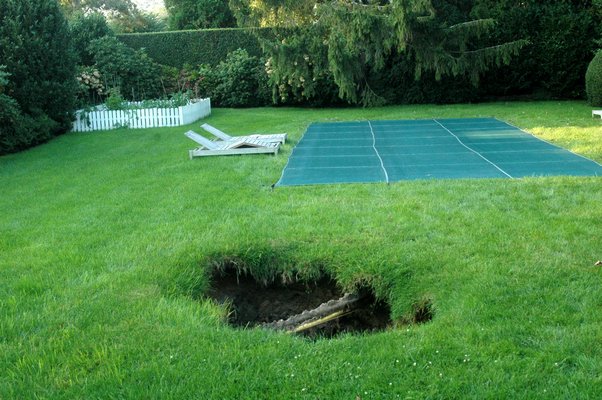
It can be slow and methodical, or fast and violent.
Lurking 1 to 20 feet underground, it can be an annoying inconvenience or a devastating, unexpected and unwelcome surprise.
But the worst part is, many homeowners never see it coming—including nine East Enders who, after this past Labor Day weekend, walked into their yards following a series of heavy rainstorms to find gaping holes where crumbling, block-style cesspools once stood.
“There are so many of those things under the ground that are just not recorded,” Russell Beal, advertising director for Emil Norsic & Son, said last week during an interview at the sanitation company’s Southampton office. “You can very often get taken by surprise.”
“The block cesspools that go back from the late ’70s into the ’20s, they’re getting older and older,” added owner Skip Norsic. “They just have a lifespan of how long these blocks are gonna last. And nothing lasts forever.”
Powered by gravity, today a septic system manages waste from toilets, washing machines, sinks and showers by directing it into a septic tank typically made of pre-cast concrete or fiberglass. However, prior to 1978, Long Island septic systems used one or more cesspools—large, underground, man-made caverns constructed from red brick, cement block, or sometimes a combination of both, that acted as drainage pools before the water could return to the soil.
Years of continual use and natural elements—rain, snow and seasonal thawing—have caused deterioration within the older cesspools and weakened their structural integrity, Mr. Norsic explained. Eventually, the cesspool’s walls give way to gravity. And, oftentimes, over-saturated soil is the tipping point, as it was in the recent flood of collapses from Westhampton to Wainscott, he said.
“With these rains, the soil was not firm anymore so it couldn’t hold in those blocks,” he said, noting that a collapse surge is fairly common after significant weather. “Generally, what will happen, you’ll have one block go. Then another one. And then it’s like a domino effect.”
Fortunately, no homeowners were hurt this time, or personal property lost, with the exception of driveways and landscaping, Mr. Norsic said. But that isn’t always the case.
In 2009, a 71-year-old man was walking across his lawn in Deer Park, New York, when he suddenly plummeted chest-deep into a cesspool. Thanks to a few nearby neighbors, he was rescued and survived. But two years earlier, in 2007, a 34-year-old landscaper wasn’t as lucky. He fell into a 6-foot-deep cesspool while riding a stand-up lawnmower, also in Deer Park. By the time a co-worker found him, it was too late.
“It’s kind of surprising no one got hurt out here with these cave-ins,” Mr. Norsic said. “In one particular case, someone put gas lines right through the cesspool. Yellow pipes right in there. When the cesspool caved in, if those lines broke, you’re looking at an explosion that could have blew the house up. It’s just incredible.”
Due to extensive rebuilding and renovation on the East End, it is unclear how many block-style cesspools are still left standing, Mr. Beal explained. Even though a contemporary home may use a modern septic system, it doesn’t mean the remnants of the old system aren’t still buried somewhere on the property, lying in wait.
“You may have had a new system put in, but they may not have decommissioned the old pool,” Mr. Beal said. “In other words, they didn’t fill it in. They just left it. So you may think, ‘I had this replaced six years ago, I’m safe.’ Not necessarily true. Those things may be sitting under your property and ready to collapse, too. And there’s really no way of knowing that. It’s a matter of the luck of the draw.”
The most important preventative measure is to be aware of where the septic system is located, Mr. Norsic emphasized, don’t build on top of it and keep an eye out for any changes in the topography. That could be a sign of a problem.
“Sometimes, you’ll see a new depression in your property and you don’t know where it’s come from. That means there’s been a collapse underneath,” Mr. Beal said. “Stay the hell away from that area and call a professional.”
“We could also give an evaluation and inspect the cesspool, but even that is not foolproof,” Mr. Norsic said. “I can remember a system where blocks were actually missing and we told the people, ‘You should do something.’ And those systems have lasted another 25, 30 years. And other ones that look absolutely perfect will cave in. It’s just a throw of the dice as far as what’s going to cave in and what’s not.”
Unless the system uses pre-cast, concrete cylinders—which require their own set of maintenance but do not collapse, Mr. Norsic said. Depending on its size, a new septic system typically runs between $3,500 and $5,000.
“I’m not saying this is going to happen to everybody. I’m not saying to run out and do this,” Mr. Norsic said of installing a new system. “What I really want to stress is just to know where your system is located and what it’s comprised of. If somebody had walked over one of these on their way from the porch to the pool, especially a child, it could have been a tragedy.”
Mr. Beal nodded in agreement. “This is the thing. There are no happy answers here, really,” he said. “If you have an old house, you either take your chances or you get it taken care of.”